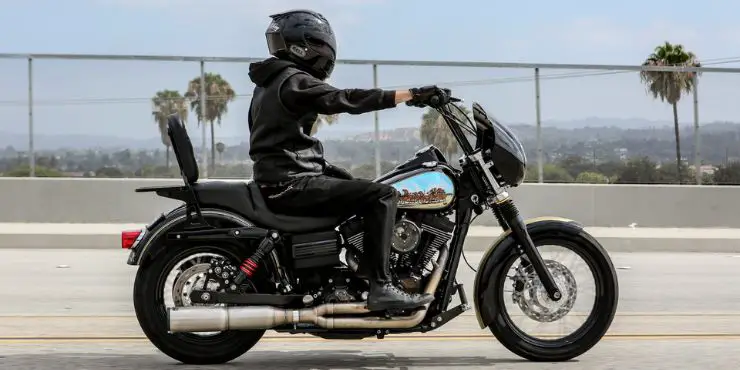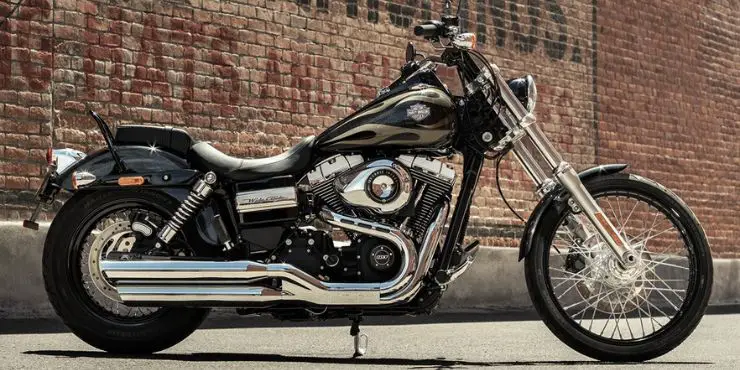Do you own a Harley-Davidson Dyna or intend to purchase one, but want to know about the weight of the bike first? If yes, then you are definitely in the right place.
A Harley-Davidson Dyna weighs between 640 and 700 pounds (wet weight), depending on the specific model and customization.
In this article, you will get to know all about the Harley-Davidson Dyna bike, how much does a Harley Dyna weight, how much weight can a Harley-Davidson bike carry, factors that determine the weight of a bike, and a lot more. Continue reading to get all the answers that you are looking for.
The curb weight of a Harley-Davidson bike
The curb weight of a Harley-Davidson bike refers to the mass of the motorcycle in running order. In other words, the curb weight is the total unladen weight of the motorcycle including lubricants like engine oil, a full tank of gas, coolant, and standard equipment. Harley-Davidson releases both the curb weight and dry weight of the models. The former is usually 20-30 pounds heavier.
For instance, the net weight of the lightest Harley-Davidson bike, the Nightster is 462 pounds. Meanwhile, its curb weight is around 481 pounds. Another example will be the Sportster S, which was a curb weight of 502 pounds. Aside from the sports line, you can even find lightweight Harley-Davidson bikes in this aspect as some of these bikes have a curb weight of 540-570 pounds depending on the model.
In contrast, the curb weight of Harley-Davidson cruiser bikes starts at 556 pounds, and it can go to 728 pounds. The heaviest 2-wheeled Harley-Davidson bikes are the full-dress touring models that have a curb weight of 820-963 pounds. The heaviest Harley-Davidson models are the trikes that have a curb weight of 1,118-1,269 pounds. You shouldn’t forget that accessories like windshields, engine guards, bags, and more can add a few pounds to the overall weight of the bike too.
How much does a Dyna weight
A Harley-Davidson Dyna is a fairly heavy bike, and it features on the high-end of the weighing scale. A Harley-Davidson Dyna motorcycle weighs around 309.8 kg or 683.0 pounds when talking about its curb weight. Meanwhile, the dry weight of the Harley-Davidson Dyna is 294.8 kg or 650.0 pounds. It is a fully loaded touring bike that is on the heavier side of the scale.
The weight of the bike is due to the materials used for taking in two passengers, luggage, a stereo with multiple speakers, and a few other items. Harley-Davidson bikes tend to be heavy and have a characteristic look and style. Since 1903, when the first Harley model was produced, the brand has been known for producing bikes that are heavy and durable.
Nothing beats speeding through the streets of a powerful Harley-Davidson Dyna with a monster engine. For bikers, the heavier the motorcycle, the better the experience. Essentially, heavier bikes are known for being comfortable and making it easier to ride on highways and long roads. This is why heavy Harley-Davidson bikes are some of the most popular ones on the market.
How much weight can a Harley-Davidson bike carry
Harley-Davidson is a brand known primarily for its motorcycle division. Although, the brand once tried its hand at producing snowmobiles and golf carts. However, the brand decided to continue producing motorcycles, as it ended up being the brand’s most successful division.
Harley-Davidson continued producing great models and released splendid bikes like Harley-Davidson Dyna, Harley-Davidson Street Rod, Harley-Davidson Street Bob, and more. Every Harley-Davidson rider is interested in knowing the weight limit of the bike. The truth is, even though sometimes Harley-Davidson bikes can handle a heavier load, the same guidelines and principles that regulate the weight of other bikes apply here.

There are certain numbers and formulae that will be helpful. Riders usually find this information helpful when consulting both the owner’s manual and service manual. Weight limits can be quite tricky to determine, as they will vary with each build and model. Further, there’s a slightly complex formulate involved and numerous factors that come into play such as tires, wear and tear, shocks, and the passenger’s weight.
The formula to determine how much weight a bike can handle
The weight limit for the Harley-Davidson bike, in most cases, can be calculated through an elaborate mathematical formula. For most bikes, this bike usually falls between 350-450 pounds. However, this is not usually the case. This formula can be easily summed up as the maximum fully loaded operational weight specified by the manufacturer minus the total weight of the bike when it is ready to ride. The resulting number will tell the driver how much weight they have for themselves, the passenger, and any luggage that they wish to bring.
The Gross Vehicle Weight Rating (GVWR) is a helpful formula in this aspect. It tells the bikers exactly how much weight a bike can hold once it is fully loaded. The GVWR is usually found in the service manual, the owner’s manual, and the VIN. The latter is present either on the steering head or a nearby part of the bike’s frame. The bike’s weight should be determined as well. The dry weight, named for a bike’s weight minus fluids and fuel, is the weight post-factory.
This number will be located in the owner’s manual or service manual as well. Another 40-50 pound gives the driver the approximate “wet weight”. It is the total weight while having the fluids and fuel added. The GVWR with the wet weight subtracted will give you the carrying capacity.
It’ll be a smart option to roughly weigh the biker, passengers, and cargo to see if the total weight exceeds the carrying capacity. However, you need to heed caution here too. The gross axle weight rating (GAWR) is not the number drivers should use, doubling the number doesn’t actually guarantee that the weight is evenly distributed between axles.
Factors that determine the weight capacity of a bike
Tire and shocks greatly affect weight
It’s important for the bikers to know the ratings and conditions of the bike’s tires and shocks. They play a significant role in determining the carrying capacity. The tires simply have to be intact and filled to the correct pressure. The drivers can sometimes neglect this practice and for that reason, the carrying capacity gets negatively affected. Tires that show signs of road damage, sidewall cracking, uneven wear, or tread depth reaching the wear limit aren’t actually intact. Not attending to this issue fast enough will be risky.
When it comes to shocks, you should consult the service manual for the bike’s design and operating specifications. Pre-load shocks are when the rear and fork shocks are compressed under no load. These come highly recommended as they’ll make the spring stiffer either through mechanical adjustment or by adding air to the system.
Wear and tear will be a significant factor
Wear and tear are important factors to consider. A bike that is older and has experienced heavy use won’t operate as smoothly or handle weight as well as a bike that is newer or hasn’t been used much. Increased weight will directly affect mechanical components. It means that you should expect changes in your motorcycle’s behavior if it is fully loaded.
If a bike’s performance has changed, then check all the mechanical components to see how intact they are. It includes checking components like sprockets and chains. With the engine under such strain, both fuel economy and oil life will be decreased significantly.
Passengers will add more weight
The presence of a passenger will also contribute to the weight of the bike. If there’s a significant weight difference between the biker and the passenger, the weight will be distributed unevenly. This will make the bike a lot more difficult to control. This will also adversely impact your safety, especially if the passenger isn’t sitting still throughout the ride.
It’s best to have a rough idea of both your and the passenger’s weight. This way, you’ll be able to distribute the weight properly, and you’ll know if you’ll be at risk riding together. Further, controlling your bike will prove easier should the passenger hold on tight, especially during sudden turns or stops.
Conclusion
Thank you for reading. Hopefully, now you know a lot more about the Harley-Davidson Dyna bike, how much does a Harley Dyna weight, how much weight can a Harley-Davidson bike carry, factors that determine the weight of a bike, and a lot more. A Harley Dyna weighs around 309.8 kg or 683.0 pounds when considering its curb weight. Meanwhile, the dry weight of the bike is 294.8 kg or 650.0 pounds.
The Harley-Davidson Dyna has long been one of the most popular offerings by the brand, and it has a long list of stunning specifications and features. Premium biking quality and the ability to carry loads of weight alongside the iconic design have made it one of the signature bikes by Harley-Davidson.

